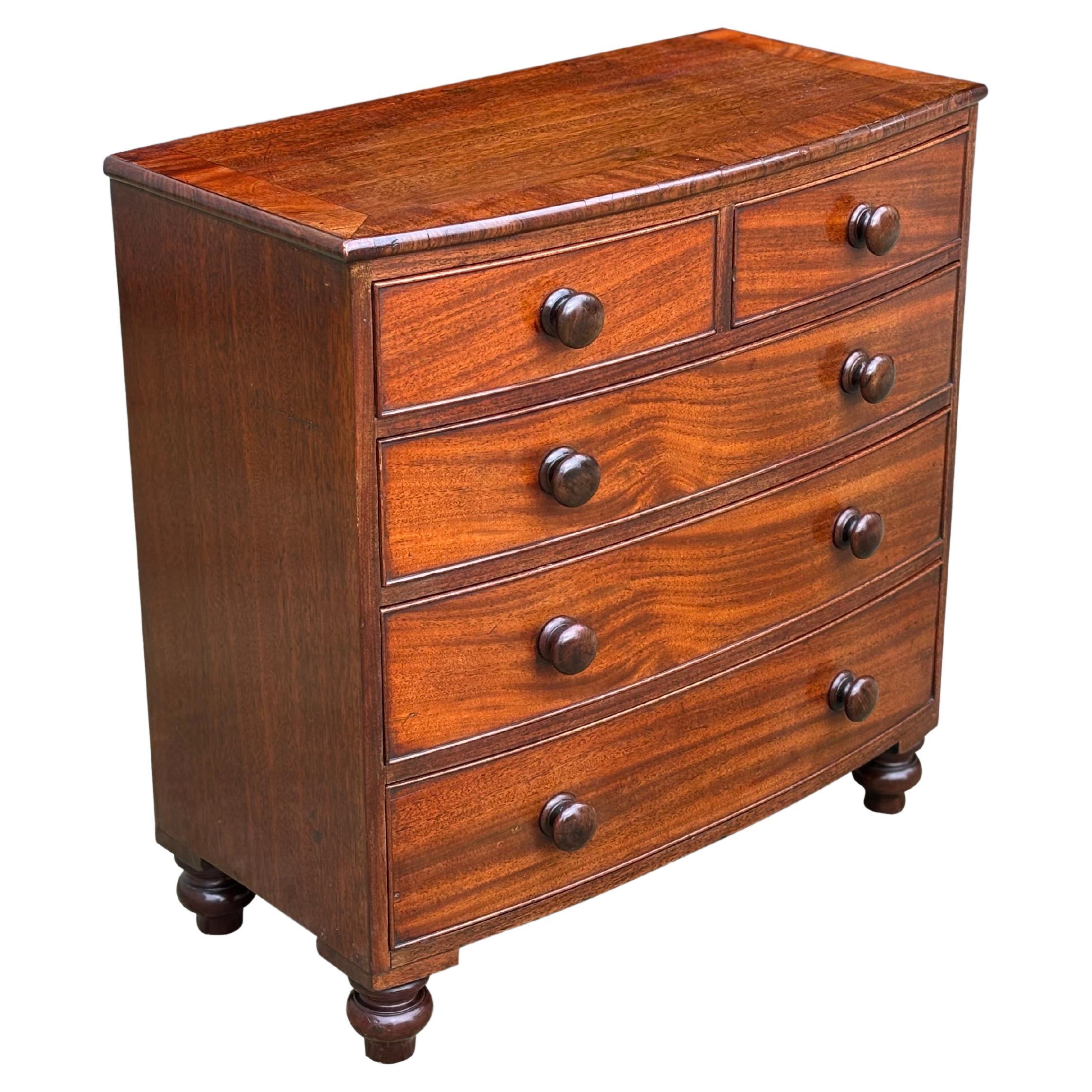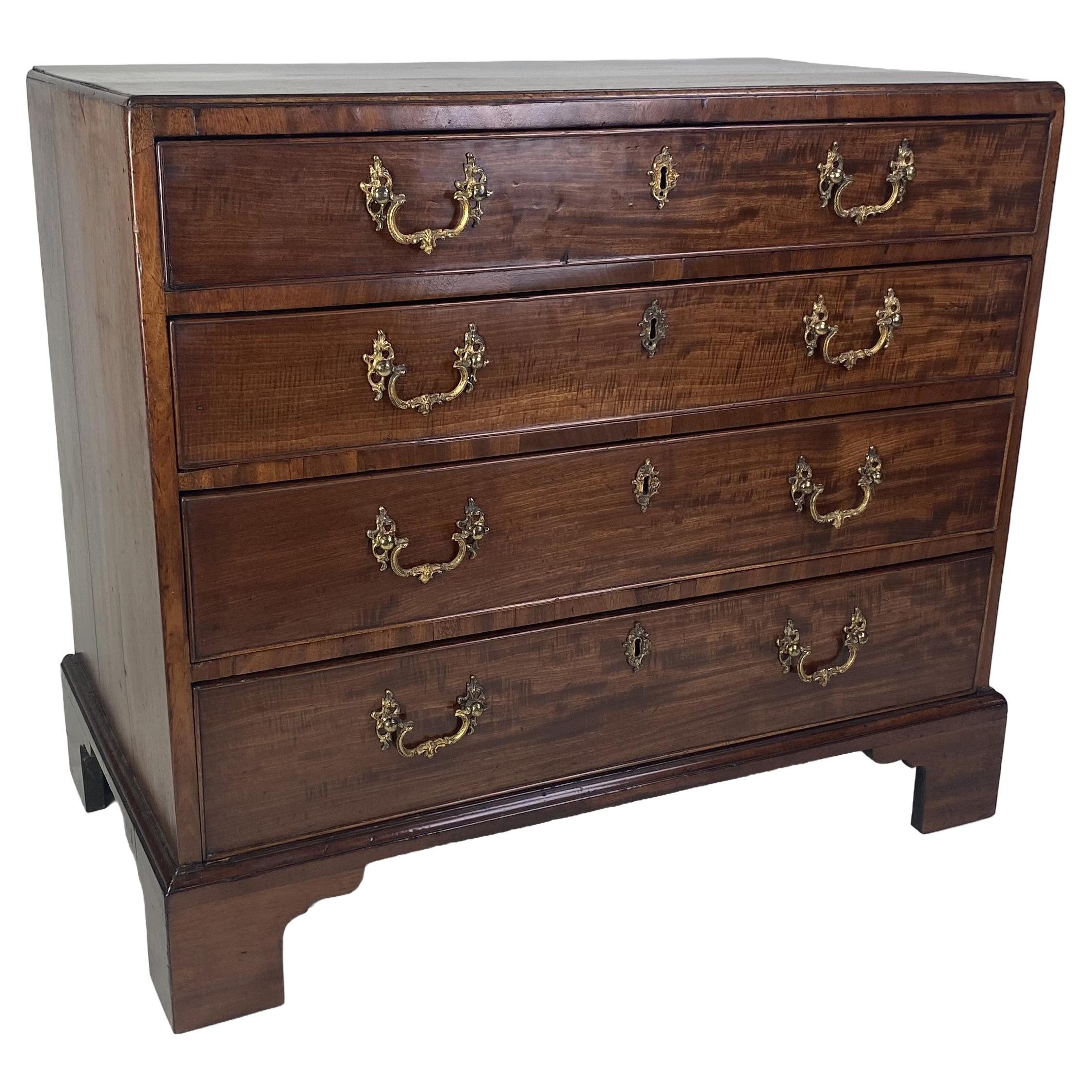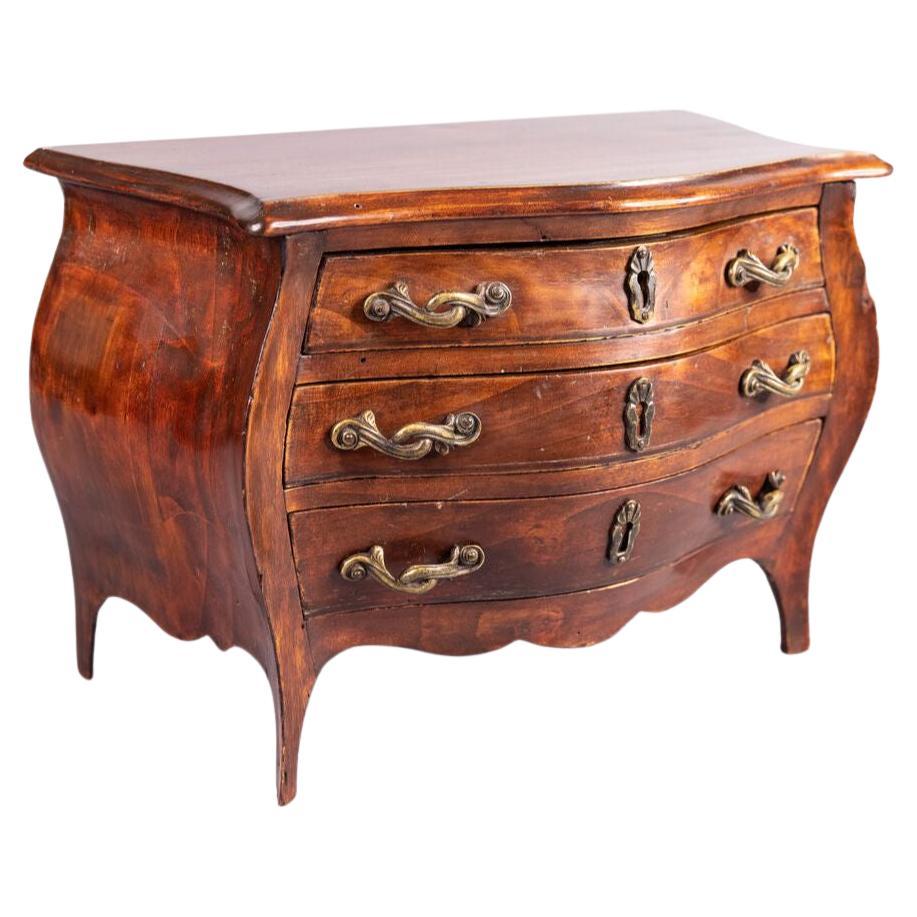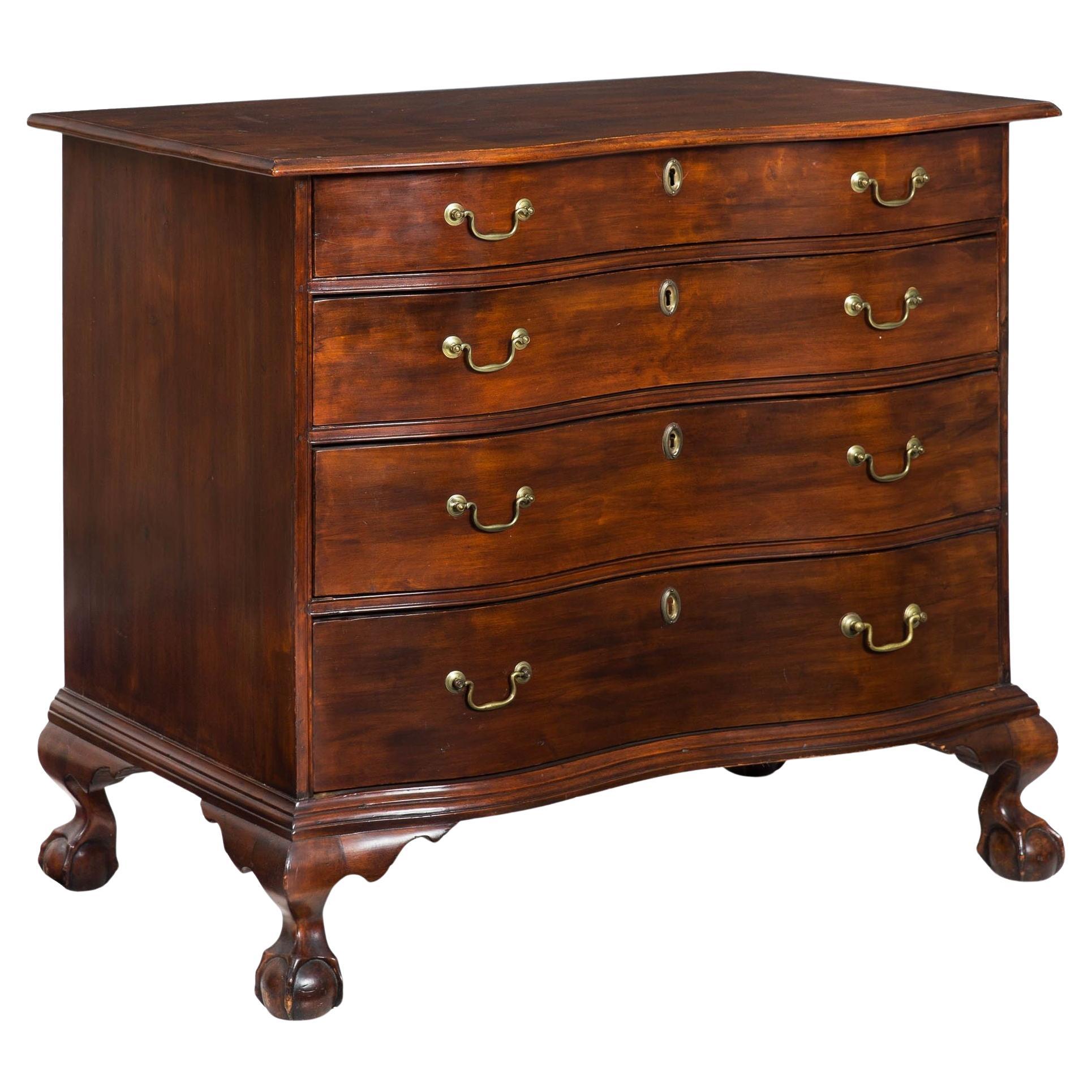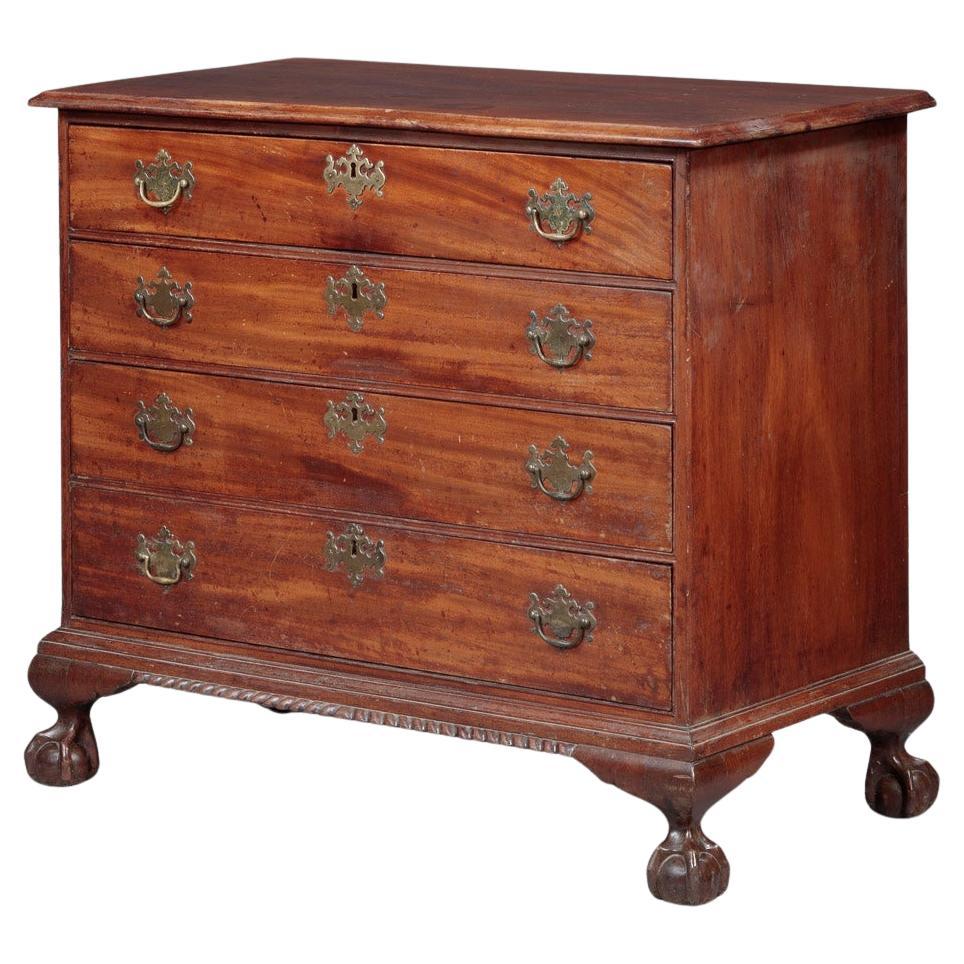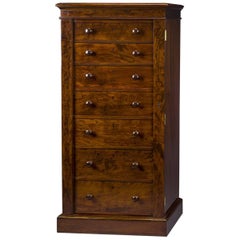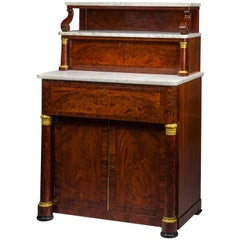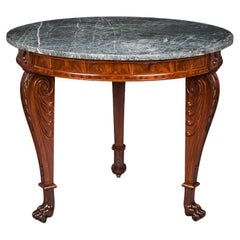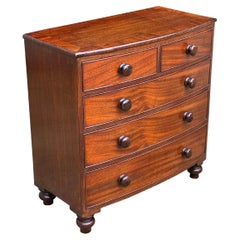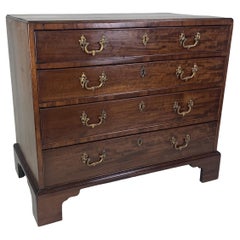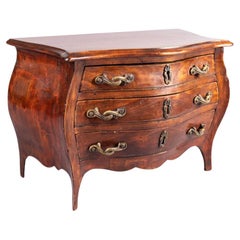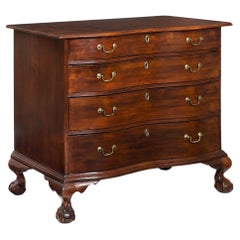Items Similar to Miniature Striped-Maple Serpentine Chest of Drawers
Want more images or videos?
Request additional images or videos from the seller
1 of 6
Miniature Striped-Maple Serpentine Chest of Drawers
$35,000
£26,519.14
€30,428.61
CA$49,250.65
A$54,140.01
CHF 28,453.51
MX$657,456.95
NOK 354,950.36
SEK 336,290.50
DKK 227,096.41
About the Item
American, probably Boston or Salem, Massachusetts
Miniature Serpentine Chest of Drawers, circa 1785-1800
Striped maple, ebony, and rosewood (secondary woods: mahogany), with brass drawer pulls
Measures: 7 7/8 in. high, 10 1/2 in. wide, 7 3/16 in. deep
Miniature furniture has often been relegated to the “toy” category, and indeed much of it is poorly made that would befit its apparent purpose as playthings for children. On the other hand, occasionally one encounters a miniature that is flawlessly crafted, much like larger pieces that came from the leading cabinet shops of their time.
The present miniature chest falls into the latter category, and from a design and cabinetmaking stand-point, stands at the top of its craft. Transitional in design, with bracket feet and a serpentine front that are heir to the Chippendale tradition, the chest is made of an unusually finely marked striped maple, or possibly satinwood, that signals the influence of the newly fashionable Neo-Classical aesthetic, which is further emphasized by the delicate inlays of ebony and crossbanding of rosewood.
Stylistically, the chest is typical of work from Eastern New England, and likely came from one of the leading shops in the cabinetmaking centers of Boston or Salem, Massachusetts, in the last years of the 18th century.
Condition: Excellent. Probably has an old refinish. The brass handles are old but not original. Witness of the original hardware is present.
- Dimensions:Height: 7.88 in (20.02 cm)Width: 11.13 in (28.28 cm)Depth: 7.25 in (18.42 cm)
- Style:Chippendale (Of the Period)
- Materials and Techniques:
- Place of Origin:
- Period:1780-1789
- Date of Manufacture:circa 1785-1800
- Condition:Refinished. Wear consistent with age and use. CONDITION: Excellent. Probably has an old refinish. The brass handles are old but not original. Witness of the original hardware is present.
- Seller Location:New York, NY
- Reference Number:Seller: FAPG 20711D1stDibs: LU90327363143
About the Seller
No Reviews Yet
Recognized Seller
These prestigious sellers are industry leaders and represent the highest echelon for item quality and design.
Established in 1952
1stDibs seller since 2010
Associations
Art Dealers Association of America
- ShippingRetrieving quote...Shipping from: New York, NY
- Return Policy
Authenticity Guarantee
In the unlikely event there’s an issue with an item’s authenticity, contact us within 1 year for a full refund. DetailsMoney-Back Guarantee
If your item is not as described, is damaged in transit, or does not arrive, contact us within 7 days for a full refund. Details24-Hour Cancellation
You have a 24-hour grace period in which to reconsider your purchase, with no questions asked.Vetted Professional Sellers
Our world-class sellers must adhere to strict standards for service and quality, maintaining the integrity of our listings.Price-Match Guarantee
If you find that a seller listed the same item for a lower price elsewhere, we’ll match it.Trusted Global Delivery
Our best-in-class carrier network provides specialized shipping options worldwide, including custom delivery.More From This Seller
View AllSeven-Drawer Tall Chest of Drawers
Located in New York, NY
Boston, Massachusetts
Seven-drawer tall chest, circa 1825.
Mahogany (secondary woods: mahogany, pine, and poplar)
Measures: 45 5/8 in. high, 27 5/8 in. wide, 14 5/8 in. deep
Inscribed (on six drawer locks): SECURE; (on seventh lock): CHUBB’S / PATENT / 57 St PAULS CHY / LONDON / CHUBB & SON / MAKERS TO / HER MAJESTY / 632284; (on one hinge): [BUR?] NE PATENT; (on master lock): 2 LEVER.
Although some Boston furniture of the Neo-Classical period is elaborately decorated with ormolu mounts, brass moldings, and carved and gilded elements, other pieces are more simple and are said to reflect the “conservative” taste of many of Boston’s great families. The simplicity evident in these pieces is not an indication of a less-expensive line of furniture or a less-sophisticated patronage, but, like the so-called “Grecian Plain Style” of Duncan Phyfe’s furniture...
Category
Antique 1820s American Neoclassical Commodes and Chests of Drawers
Materials
Mahogany
Butler's Desk and Etagére, New York, Possibly Duncan Phyfe
By Duncan Phyfe
Located in New York, NY
Butler’s Desk and Etagére, circa 1825
New York, possibly by Duncan Phyfe
Mahogany (secondary woods: mahogany, pine, poplar), with ormolu mounts, marble,...
Category
Antique 1820s American Neoclassical Cabinets
Materials
Mahogany
Center Table with Scroll Legs, Paw Feet and Marble Tops
By Thomas Seymour
Located in New York, NY
Center Table, about 1818–20
Attributed to Thomas Seymour (1771–1848), working either for James Barker or for Isaac Vose & Son, with Thomas Wightman (1759...
Category
Antique 1810s American American Classical Center Tables
Materials
Wood, Mahogany
Card Table in the Rococo Taste
By Charles A. Baudoine
Located in New York, NY
RECORDED: cf. Anna Tobin D’Ambrosio, ed., Masterpieces of American Furniture from the Munson-Williams-Proctor Institute (Syracuse University Press, Utica, New York, 1999), pp. 85, 86, 87 illus. the Munson-Williams-Proctor tables // cf. The Metropolitan Museum of Art, New York, 19th Century America–Furniture and Other Decorative Arts (1970), exhib. cat., [n.p.] no.133
This table is identical to a pair of card tables bearing the stenciled label of Charles A. Baudouine of 335 Broadway, New York, which were acquired by James and Helen Munson Williams of Utica, New York, in May 1852 for their home, Fountain Elms, which is where they remain today as part of the Munson-Williams-Proctor Art Institute collection. The Williams tables were billed as “1 Rosewood Multiform Table” at $160 for the pair, and they were indeed “multiform” in that they could be used separately and folded as a pair of console tables, opened as a pair of card tables, or joined together as a center table. The present table varies essentially in the fact that it does not include the mechanism that would have allowed it to be attached to another to form a center table.
Of French descent, Baudouine was born in New York in 1808. He made his debut as a cabinetmaker in the New York directory of 1829/30, where he is listed at 508 Pearl Street. By 1839/40 he relocated to Broadway, where he remained in business at various addresses until about 1854. A sense of the scale of Baudouine’s operation is given by German immigrant cabinetmaker Ernest Hagen...
Category
Antique Mid-19th Century North American Rococo Revival Card Tables and T...
Materials
Wood, Rosewood
Fan-Carved Wood Mantel in the Federal Taste
Located in New York, NY
New York,
Fan-carved mantel in the Federal taste, circa 1812
Pine
Measures: 66 1/4 in. high, 90 3/8 in. wide, 13 1/4 in. deep
Within the genre of carved rather than plasterwork mantels of the Federal Period, no example that has come to light is more perfectly designed or more carefully wrought than the present one, which is an amazing symphony of fans, urns, beads, and other Neo-Classical devices, all ultimately influenced by the plasterwork designs of the English architects Robert (1728–1792) and James (1732–1794) Adam.
Of a type that proliferated in the area bounded by the northern New Jersey counties of Bergen and Passaic, the Hudson Valley, and western Long Island, the mantel is representative of work that flourished in the first couple of decades of the 19th century. While most of the woodwork of this style that has survived is found in interiors, various examples of exterior doors and other trim have been noted, but most examples have disappeared as a result, variously, of natural deterioration and purposeful demolition in anticipation of development.
Although considerably larger in scale and more elaborate in ornament than a mantel that has been in the collection of the Brooklyn Museum since 1944 (acc. no. 44.55; photograph in Hirschl & Adler archives), the present mantel is so close in style and conception to that example that it likely originated in the same house.
The Brooklyn mantel is documented as having been removed from a house built by Judge Isaac Terhune (1762–1837), an eminent lawyer and judge. The house was situated on King’s Highway, at the corner of Mansfield Place, at the edge of South Greenfield, a village in northern Gravesend, Brooklyn. A photograph of the house, taken by the German e´migre´ photographer, Eugene Armbruster (1865–1933), is in the collection of the New-York Historical Society.
Terhune is ultimately descended from the Dutch-Huguenot e´migre´ Albert Albertson Terhunen, who died in Flatlands, Brooklyn, in 1685.The family eventually spread out through New Amsterdam, Long Island, and Bergen County, New Jersey. Terhune’s great-grandson, also Albert (1715–1806), left a sizable estate to his six surviving children, including his second child and second son, Isaac.
Judge Terhune lived in the house until his death in 1837, at which time, according to an article in The New York Times for November 27, 1910, he, having died without issue, “left the White Frame Mansion with its exquisitely carved doorway, beautiful mantels, and other interior adornments to his brother John” (Part Six, p. 11).
The article continues:
After the latter’s death, the house and its estate of about 70 acres passed through several owners, eventually being purchased in 1853 by Benjamin G. Hitchings [1813–1893].
The house next passed to Benjamin’s son, Hector, who had been born in the house, and then lived there for 25 years. He sold it in 1910 in partial payment for a Manhattan apartment house. After thus having been sold to a real estate developer, the Hitchings property was subdivided into Hitchings Homestead. The house survived until about 1928, at which time it was razed and a Deco-style apartment house with the address 2301 Kings Highway was constructed on the site and occupied in 1935.
By 1910, the fate of the house, in an area of Brooklyn that was being rapidly developed, was becoming obvious. The Times article reported:
The house has been well kept up, but fearing lest the hand of time or vandals might deal harshly with some of its choice bits of carving, Mr. Hitchings removed a few years ago a few beautifully carved wood mantels...
Category
Antique 1810s American Neoclassical Fireplaces and Mantels
Materials
Wood
Pier Table
Located in New York, NY
One of the signature forms of the Neo-Classical period, the pier (or console) table received its name from its typical use against the wall, or pier, between two windows. Pier tables...
Category
Antique 1810s American Neoclassical Tables
Materials
Marble, Brass, Bronze, Lead
$65,000
You May Also Like
19th Century Miniature Bow Fronted Chest of Drawers
Located in Petworth,West Sussex, GB
A mid 19th century mahogany miniature bow fronted chest of drawers, with moulded mahogany cross banded top, above two short over three long drawers, fitted with turned rosewood knobs...
Category
Antique 19th Century British Early Victorian Commodes and Chests of Drawers
Materials
Wood
Small Chippendale period mahogany Chest of Drawers
By Thomas Chippendale
Located in Folkestone, GB
A fine quality late 18th century chest of drawers of small size, with moulded edge caddy-top above four long graduated drawers, the top of which is fully fitted with various lidded a...
Category
Antique 18th Century English Chippendale Commodes and Chests of Drawers
Materials
Mahogany
$5,437 Sale Price
20% Off
19th C. French Mahogany Salesman Sample Miniature Serpentine Chest of Drawers
Located in Pearland, TX
A gorgeous antique French miniature mahogany salesman sample tabletop chest of drawers, circa 1880. Antique salesman samples were used in the...
Category
Antique 19th Century French French Provincial Commodes and Chests of Dra...
Materials
Mahogany
$1,047 Sale Price
29% Off
American Chippendale Birchwood Serpentine Chest of Drawers, circa 1770
Located in Shippensburg, PA
A very fine reverse-serpentine (also known as "Oxbow") chest of drawers from the Chippendale period, it is a product of the North Shore of Massachusetts circa 1780 and probably origi...
Category
Antique 18th Century American Chippendale Commodes and Chests of Drawers
Materials
Brass
New York Chippendale Straight Front Chest of Drawers
Located in New York, NY
Chippendale Chest of Drawers
New York Circa 1765
Primary Wood: Mahogany
Secondary Woods: Tulip Poplar, White Pine
Height. 32 1/2 inches
Width. 38 1/2 inches
Depth:19 3/4 ...
Category
Antique 1770s American Chippendale Commodes and Chests of Drawers
Materials
Mahogany, Poplar, Pine
English Wood Serpentine Chest of Drawers
Located in Lisboa, Lisboa
Serpentine chest of drawers with flat ball feet. Composed of three large drawers and a sturdy structure, the piece is reminiscent of the Biedermeier style or the transition to Art De...
Category
Early 20th Century English Biedermeier Commodes and Chests of Drawers
Materials
Wood
More Ways To Browse
Chippendale Serpentine Chest
18th Century Chest Of Drawers New England
Striped Chest Of Drawers
Salem Chest
Italian Burl Wood Chests
Jacobean Style Cabinet
Louis Dresser Marble Top
Paris Flea Market
Tool Chest
Used Tool Chests
Walnut Small Chest Drawers
4 Drawer Serpentine Chest Of Drawers
Antique Butler Cabinet
Antique Green Chest
Antique Walnut Chest On Stand
Carved Bombe Chest
Demi Lune Chest Of Drawers
Drop Front Chest
